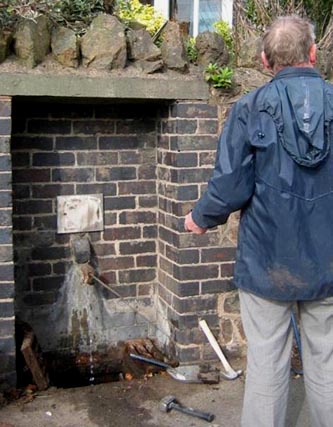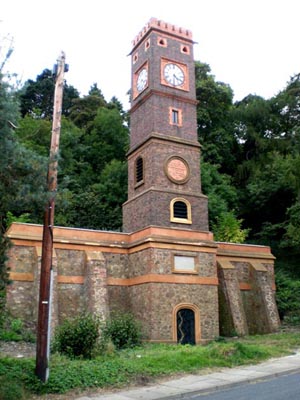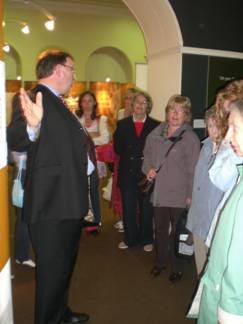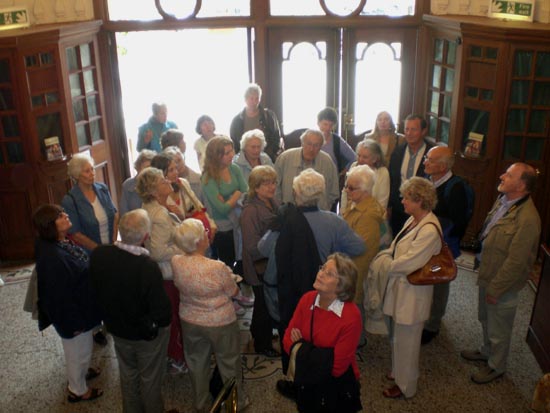
| 
|


Friends Newsletter No. 19
October 2007

From
Saints in Flowers.
We have heard of saints depicted in stained glass windows but now perhaps we should be considering flowers. At the recent annual Blessing of the Waters ceremony in the
 Originally in the chapel of the
Originally in the chapel of the
Should we have a spring decorated to celebrate St Werstan - let us know if you would like to get involved.
Water, water, every where,
'tis disaster we do think,
Water, water. every where,
 favourite bottled water from Colwall were urgently shipped to those in need in the local communities without charge. This amounted to a
favourite bottled water from Colwall were urgently shipped to those in need in the local communities without charge. This amounted to a More light on St Werstan
Those who have read 'The Illumination of St Werstan the Martyr' will appreciate the difficulties in piecing together the story of this local saint who was responsible for founding the original religious cell in Malvern in the 11th century. Our researches continue and a fresh piece of information has come to light which sheds more light on the first chapel on the site of his cell. In 1843 a broken cross that was a roof decoration was discovered near the Priory. It was made of fired clay, glazed and measured about 14 inches across the arms. It is suggested that was similar to, if not the original roof decoration of Werstan's chapel depicted in the medieval founder's windows in the Priory. It is known that at the time of the discovery, the chapel had already been demolished. We are anxious to trace whether the cross has survived, possibly as a garden ornament somewhere in Malvern and any other early artefacts that may be associated with this ancient building, which predated the Malvern Priory. Can you help?
St Werstan's Labyrinth project continues and we now have a detailed scheme designed by a local firm of landscape architects. We now have to get the overall scheme approved by the Council and develop a funding strategy, probably based on laying the labyrinth in year one and then developing the overall site at Rose Bank Gardens in an ongoing series of projects over several years. This enables us to utilise the funding that has been pledged to date and to enhance the site over the ensuing years as additional funding is forthcoming.
To find out more about St Werstan, patron saint of Malvern Springs and Wells do read 'The Illumination of St Werstan the Martyr' available from the Priory bookshop and elsewhere or call Cora for a copy - price 9 pounds 99 pence.
What are Holy Wells?
It's no surprise that the definition of 'Holy Well' has been something researchers in the field have argued over. Some wells are actually called 'Holy' in local tradition, while others bear the names of Christian saints. The traditional view is that many holy wells began as pagan sites and were adopted by the Christian Church and rededicated to saints who then displaced the old gods who were formerly worshipped there. Others originate from their use as early Christian facilities used for baptisms and domestic purposes by the monks who founded an order on the site. In many instances a well of local repute for healing became known as a holy well. A very few have names which indicate some sort of pagan reverence in the past. There are whole classes of water-sites called by names which may, or may not, reflect some hidden or forgotten sanctity. Sometimes they are not named at all, but a story, miraculous ability or piece of strange folklore attaches to them which makes them special and these are usually subsumed within the title of 'holy well'. Sometimes people think all holy wells had healing abilities or mineral properties, but this isn't so. In fact in the great majority of cases it isn't at all clear how a particular spring came to be thought of as 'holy'.
Examples - St Winefrides Well Flintshire - Walsingham - St Werstan’s Well - Southstone Rock
Sacred wells and springs can be found in all continents and cultures. In our own case St Augustines Well owes its provenance to a tenth century charter describing the boundaries of Leigh parish. It says that the boundary near Storridge passed near the Hwitan Wyllan or white well, now known as the Holywell. It is said that
For more information about Holy Wells try http://www.geocities.com/jamesrattue/wells_home.html

CLOCK TOWER
The Clock Tower has taken a further step towards eventual restoration and we can now report that the clock is working. Also the scaffolding is down and the controversial gate to the fountain chamber installed. At time of writing there is no sign of water at the new spout. It is good to see the building free from the insidious ivy that covered much of it and we await further developments in due course. Have a look and see what you think.
Cora on the Box (yet again!) - Did you see the recent 'Great British Journeys' programme on BBC2 that went to Holywell in Flintshire? As we reported on Newsletter 15 we have been working with a production company and the result was Cora being interviewed by Nick Crane about the history and application of the waters at Holywell. She has a video of the programme and will doubtless be delighted to show it off if you want to see it! (boring!)
Bad History
The problem with bad history is that others rely on it and the errors are perpetuated. We continually see examples of badly researched and interpreted history and when it is subsequently published the result is that others take it as fact. This especially applies when it is marketed under the banner of plausible organisations. The long term result is that mistakes are perpetuated over many years with new generations of amateur authors adding to the cascade of misinformation that tumbles down through the decades. Modern day scholars have to be particularly vigilant about their source material and how much credence they can put on it. Also similar care is required about the interpretation and presentation of the facts, in order to portray an accurate as possible historic scenario. Just because it is in print somewhere does not mean that it is accurate.

In July this year a party of Friends of Malvern Springs and Wells joined the Malvern Civic Society on a visit to Buxton Spa in Derbyshire to investigate both the heritage and modern day spa developments. The guide for the day was Dr Bruce Osborne, author, broadcaster and spa historian in conjunction with Ken Smith of Buxton Civic Society.
Buxton as a health resort dates back to Roman times. Like Malvern, Buxton is famous for its natural water sources, unlike Malvern however these are warm thermal waters. Buxton developed as a modern spa from the 16th century when Mary, Queen of Scotts was incarcerated there because of her rheumatism by Elizabeth I. Subsequently, again like Malvern, Buxton developed into one of the major 19th century spas of

On the way to St Anne's Crescent, the former focus of 19th century spa activity, the opportunity was taken for a conducted tour of the town centre. The magnificent theatre, winter gardens and other historic buildings give Buxton a unique charisma that differentiates the resort from elsewhere. The party was able to see The Old Hall, now a hotel but formerly where Mary, Queen of Scots stayed. The waters of St Anne's Well were then inspected together with the historic pump room before meeting Jonathan Ogden of Danubius Hotels and Spa. This organisation is a world leader in spa developments. They are in the midst of a major project to save the Grade I listed St Anne's Crescent and Grade II Natural Baths and return it to former glory as a spa centre. The party was able to enter the building and view the impressive Assembly Rooms and other aspects of the historic interior as well as learn about how Danubius along with their project partners CP Holdings Ltd. and The Trevor Osborne Property Group are tackling the problems involved. An expenditure of 38 million pounds is proposed, including assistance from the Heritage Lottery Fund, the East Midlands Development Agency and the Local Authorities. The planned completion date is 2010 and the building has already been standing empty for 18 years, hence the 'at risk' status with English Heritage.
The party returned to Malvern for early evening. On the coach as it returned, there was much discussion as to how Malvern could attract a similar large initiative to restore not only spa business to the town but also recreate the distinctive environment of a health resort.
HLF Restorations
As well as Clock Tower mentioned elsewhere we see that a better water supply is now flowing at the Lower Wyche Spout. The Jubilee Fountain at Malvern Wells is about to have water reinstated. The blue pipe work coming out of the back of the Jubilee Fountain certainly suggests that something is happening at last on this HLF project that is due to complete within the next few weeks. Work is also underway at Hay Slad, including new paving and improvements to the spout. We will keep our web site updated as the information becomes available.
Who are Friends? Friends promote research, conservation and celebration of the Springs, Spouts, Fountains and Holy Wells of the Malvern Hills and of Great Malvern as a
Email: springs@thespas.co.uk (click here to send an email)
Website: Click Here
SUPPLEMENTARY INFORMATION
 Newsletter Archive which can also be accessed from our WEB SITE INDEX.
Newsletter Archive which can also be accessed from our WEB SITE INDEX.
Friendship - There is no charge made for joining Friends of Malvern Springs and Wells. Just let us have your email address and we will send our newsletters, which are usually two monthly. Please be aware that some email addresses block large circulation emails. Do feel free to participate in our activities by contacting us below.

Best wishes, Cora & Bruce
Tel. 01737 213169 email bruce@thespas.co.uk
Tel. 01684 561215 email cora@malvernspa.com
1) TOPOGRAPHICAL LOCATION:
Malvern Hills - arguably Britain's original National Park
3) INFORMATION CATEGORY:
Springs and Wells General InterestHistory & Heritage
Friends Newsletter


